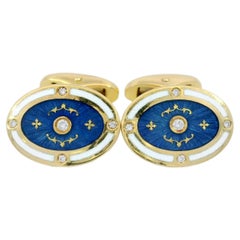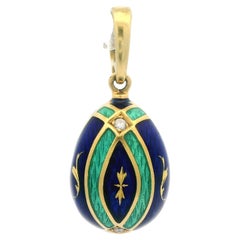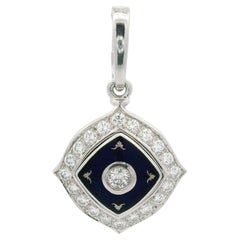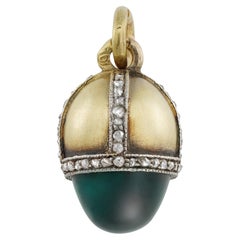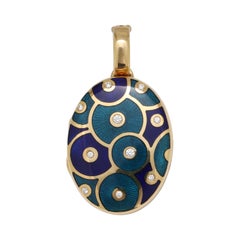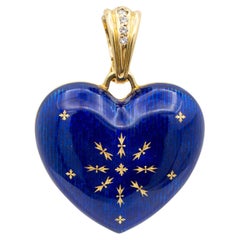Fabergé Jewelry
While the House of Fabergé is best known for creating the lavishly ornate and intricately devised Imperial Easter eggs given by the last czars to their families as annual holiday gifts, it was the most prestigious Russian luxury goods maker of the late 19th and early 20th centuries.
Serving the aristocracy and the well-to-do through stores in St. Petersburg, Moscow and as far afield as London, Fabergé crafted a wide range of brooches and other jewelry, clock cases, silver and myriad objets de vertu that included picture frames, cigarette cases, cufflinks and carved hardstone floral and animal figurines. Following the revolution, the firm was closed by the Soviet state in 1918.
Master goldsmith Gustav Fabergé, a descendant of Huguenot emigrées, founded the company in St. Petersburg in 1842. The firm did a brisk trade among the lesser nobility and the merchant class, but it flourished under the guidance of Gustav’s eldest son Peter Carl Fabergé — known also as Karl Gustavovich Fabergé — who took over in 1872.
Cosmopolitan, widely-traveled and himself a master goldsmith — he was sent on a Grand Tour in the 1860s — the younger Fabergé drew early design inspiration when he volunteered to catalogue and restore pieces in the imperial jewelry collection in the Hermitage.
Fabergé pieces based on historical jewelry from the Hermitage caught the attention of Czar Alexander III at a Moscow exhibition in 1882, and three years later he commissioned the first Imperial Easter egg as a gift for the czarina. Czar Nicholas II continued the tradition, presenting two eggs each Easter — one for his wife and one for his mother.
Relatively simple in design compared to the complex cloisonné-adorned eggs that followed, the first Fabergé egg was a white-enameled ovoid containing a gold “yolk” that held a gold hen, which in turn contained a replica of the imperial crown from which hung an egg-shaped ruby pendant.
As the appointed goldsmith to the royal court, the House of Fabergé became the darling of Russian aristocrats as well as wealthy patrons across Europe. Many and varied objets — hundreds of thousands by one count — were made to meet their demand. The firm employed some 500 craftsmen and designers when it was shuttered.
After the Russian Revolution, the Fabergé name and trademark endured a checkered passage through the 20th century.
Family members left their homeland in 1918 and set up a new business in Paris that was mainly concerned with repairing and restoring earlier-made wares. The name was adopted by an American fragrance and beauty products maker in the late 1930s, and later authorized by the family in a 1951 agreement. The trademark has been subsequently sold several times, and attached to numerous products including jewelry.
Fabergé pieces are richly redolent of a romantic past, and a source of thorough delight — for connoisseurs, true Fabergé refers to items made in the firm’s brief, golden decades from 1885 to 1917.
Collectors are advised to make a study of Fabergé works in museum collections such as the Victoria & Albert and the Royal Collection in London to gain an understanding of the quality of genuine goods made by the original firm, and then to purchase only from reputable and reliable dealers, such those at 1stDibs.
Find Fabergé eggs for sale and other objects and vintage jewelry on 1stDibs.
Late 20th Century Fabergé Jewelry
Diamond, Gold, 18k Gold, Yellow Gold, Enamel
20th Century Fabergé Jewelry
Diamond, Gold, 18k Gold, Yellow Gold, Enamel
21st Century and Contemporary Fabergé Jewelry
Diamond, Gold, 18k Gold, White Gold, Enamel
Early 20th Century Fabergé Jewelry
Diamond, Sapphire, Gold
Early 2000s German Art Deco Fabergé Jewelry
Diamond, 18k Gold, Yellow Gold, Enamel
Late 20th Century Unknown Fabergé Jewelry
Diamond, Gold, 18k Gold, Yellow Gold, Enamel
Early 1900s Russian Antique Fabergé Jewelry
Enamel
1980s Vintage Fabergé Jewelry
Diamond, Gold, 18k Gold, Yellow Gold, Enamel
1990s European Fabergé Jewelry
Diamond, Sapphire, Emerald, Gold, Enamel
2010s British Belle Époque Fabergé Jewelry
Diamond, Opal, Blue Sapphire, Pink Sapphire, Yellow Sapphire, Green Sapp...
Early 1900s Russian Russian Empire Antique Fabergé Jewelry
Enamel
Late 19th Century Art Nouveau Antique Fabergé Jewelry
Diamond, Platinum
Early 20th Century Russian Fabergé Jewelry
Silver
Late 19th Century Russian Art Nouveau Antique Fabergé Jewelry
Rose Gold, Yellow Gold
Late 20th Century Fabergé Jewelry
Diamond, Gold, 18k Gold, Yellow Gold
21st Century and Contemporary Fabergé Jewelry
Diamond, 18k Gold, Enamel
Late 19th Century Victorian Antique Fabergé Jewelry
Yellow Gold
21st Century and Contemporary Fabergé Jewelry
Diamond, 18k Gold, White Gold, Enamel
20th Century Russian Edwardian Fabergé Jewelry
Diamond, Rose Gold, Yellow Gold
1890s Antique Fabergé Jewelry
Gold, 14k Gold, Yellow Gold
2010s Fabergé Jewelry
Diamond, White Gold, Enamel
2010s Fabergé Jewelry
Early 2000s Fabergé Jewelry
Diamond, 18k Gold, White Gold, Enamel
1890s Antique Fabergé Jewelry
Amethyst, Quartz, Gold, 14k Gold, Yellow Gold
Late 19th Century Russian Victorian Antique Fabergé Jewelry
Blue Sapphire, Diamond, Ruby, Yellow Gold
Late 19th Century Russian Victorian Antique Fabergé Jewelry
Rock Crystal, Blue Sapphire, Gold
Early 20th Century Russian Fabergé Jewelry
14k Gold
Early 2000s German Modern Fabergé Jewelry
Diamond, 18k Gold, Yellow Gold, Enamel
1890s Russian Russian Empire Antique Fabergé Jewelry
Rose Gold
Late 19th Century Russian Victorian Antique Fabergé Jewelry
Yellow Gold
2010s Fabergé Jewelry
2010s Fabergé Jewelry
2010s Fabergé Jewelry
2010s Fabergé Jewelry
2010s British Belle Époque Fabergé Jewelry
Diamond, 18k Gold
2010s Fabergé Jewelry
19th Century Russian Antique Fabergé Jewelry
Diamond, Gold, Enamel
Early 2000s German Modern Fabergé Jewelry
Diamond, 18k Gold, Gold, Enamel
Early 1900s Russian Art Nouveau Antique Fabergé Jewelry
Carnelian, Quartz, Gold, Enamel
20th Century Russian Edwardian Fabergé Jewelry
Rose Gold, Yellow Gold
1990s French Fabergé Jewelry
Diamond, Emerald, Ruby, White Gold
2010s British Belle Époque Fabergé Jewelry
Diamond, Blue Sapphire, 18k Gold
2010s Fabergé Jewelry
Early 20th Century Edwardian Fabergé Jewelry
Chalcedony, Yellow Gold
2010s Fabergé Jewelry
Rose Gold, Enamel
Late 19th Century Russian Victorian Antique Fabergé Jewelry
Silver
Early 2000s German Art Deco Fabergé Jewelry
Diamond, 18k Gold, White Gold, Yellow Gold, Enamel
21st Century and Contemporary Fabergé Jewelry
18k Gold, Yellow Gold
Early 20th Century Russian Edwardian Fabergé Jewelry
Diamond, Gold, Platinum
Early 20th Century Russian Russian Empire Fabergé Jewelry
Silver, Enamel
Early 2000s German Modern Fabergé Jewelry
Diamond, 18k Gold
Late 20th Century Unknown Fabergé Jewelry
Diamond, 18k Gold, Yellow Gold, Enamel, Gold
Early 2000s German Art Nouveau Fabergé Jewelry
Diamond, 18k Gold, Rose Gold
Late 19th Century British Belle Époque Antique Fabergé Jewelry
Diamond, Enamel, Gold Plate, Silver
2010s German Fabergé Jewelry
Sapphire, 18k Gold, Rose Gold, White Gold
1980s American Vintage Fabergé Jewelry
Diamond, Sapphire, 18k Gold
1990s European Fabergé Jewelry
Gold, Enamel
1990s German Art Nouveau Fabergé Jewelry
18k Gold, Yellow Gold, Enamel
Late 19th Century Russian Russian Empire Antique Fabergé Jewelry
Diamond, Ruby, Blue Sapphire, 14k Gold, Yellow Gold
Late 19th Century Russian Victorian Antique Fabergé Jewelry
Diamond, Ruby, Blue Sapphire, Yellow Gold
Fabergé jewelry & watches for sale on 1stDibs.
- Did Faberge make jewelry?1 Answer1stDibs ExpertApril 5, 2022Yes, Faberge makes fine jewelry and other items including silver tableware. Although Faberge is known around the world for their Easter eggs, the House of Faberge has a long history of creating exceptional jeweled items and paying great attention to detail. The brand is still in business today and offers a wide range of luxe jewelry options. On 1stDibs, find a collection of authentic Faberge pieces from some of the world’s top sellers.
- 1stDibs ExpertOctober 24, 2024To tell if a ring is an antique, see if you can locate a maker's marking on the inside of the band. If you can, research the artisan, company or workshop using trusted online resources. By learning when they were active and reviewing image galleries of their work, you can often estimate approximately when a particular ring was produced. If your ring is 100 years old or older, it is an antique. In the event that you can't find a maker's mark or still have lingering questions about your ring's age, consult a certified appraiser or knowledgeable antique dealer. Find a wide variety of antique rings on 1stDibs.
- How much are Fabergé eggs worth?1 Answer1stDibs ExpertAugust 15, 2024How much Fabergé eggs are worth depends on their age, condition and other factors. One of the most valuable examples is the Third Imperial Egg, produced in 1887, which has an estimated value of $33.1 million. The House of Fabergé is best known for creating the lavishly ornate and intricately devised Imperial Easter eggs given by the last czars to their families as annual holiday gifts, but it was also the most prestigious Russian luxury goods maker of the late 19th and early 20th centuries. If you own any Fabergé pieces, a certified appraiser or knowledgeable antique dealer can provide you with an estimate of their value. Shop a selection of Fabergé jewelry and decorative objects on 1stDibs.
- Where are Faberge watches made?1 Answer1stDibs ExpertApril 5, 2022Faberge watches are made in Geneva, Switzerland. Faberge is Renowned for its luxury jewelry and timepieces and has enthusiasts and collectors worldwide. Shop a collection of antique and contemporary Faberge watches from some of the world’s top sellers on 1stDibs.
